« September 2008 |
Main
| November 2008 »
 October 30, 2008 | It's a drag...
October 30, 2008 | It's a drag...
In our March 2008 "Tips and Tricks" article on swing, we explored three different observable components of often intangible concept of swing, " It don't mean a thing, if it ain't...." We looked at Shuffle, Articulations, and Drag as audible mechanisms in creating the swing feel.
We looked at the meandering subdivision of duple to triple and everything in between. We also examined how different emphases in the pick stroke could alter the ability to control the articulation and attack, "Doo BEE Doo BEE Doo..." What we want to do here is listen to a specific example of the notion of drag, and nobody better to show us than the Doctor of Mando Cool, Don Julin.
Our most recent audio addition to the PROFESSIONAL'S SOUND LAB, has the Michigan multi-instrumentalist and composer offering his interpretation of "Lydia O'Lydia," the first of the five concept tunes out of the "Getting Into Jazz Mandolin" book. Though the lesson itself is introducing the Lydian Mode as improvisation fodder, the audio example also demonstrates quite well the element of "drag."
Listen:  Don Julin in "Lydia O'Lydia" Don Julin in "Lydia O'Lydia"
When Don delivers his notes, listen very carefully how he lays back his attacks. There's no strict "ricky-ticky" metronomic sterility in his phrasing; it's very much a "feel" issue, but you can intuitively measure the phenomenon with your own ears. The impact slows the pulse and relaxes the listener. It's very much a mood thing, but not something you can't incorporate in your own playing.
Try taking one of your favorite jazz standards, or really any slow pop ballad and see what you can do phrasing your attacks similarly. Note, we aren't talking about slowing the tempo down, just delaying each attack a little. You still want metronomic precision in the accompaniment; it's the juxtaposition of the two that yields you that marvelous swing feel.
Download free PDF copy of the tune: Lydia O'Lydia
Listen to other artists' interpretations of the concept songs and free accompaniment tracks from "Getting Into Jazz Mandolin"
More about Don Julin
Posted by Ted at 9:02 AM
 October 23, 2008 | Home stretch.
October 23, 2008 | Home stretch.
Bennie was approaching his 50th birthday, and felt like it. After two incidents with irritating back injuries in the last decade, culminating with multiple trips to the Chiropractor, his recent third injury had him going to a Physical Therapist for a solution that might demand more self-direction, and put him in control of his own mending. Having earlier PT success with therapy on his knees (Bennie remained an avid long distance runner), he assumed he could duplicate the achievement on his aching back.
Through a series of prescribed isometric exercises and disciplined Yoga-like stretches, he and his therapist were able to counter the only natural debilitation age had wrought on his back, but only if the routine was done regularly, frequently, and in small doses. His therapist developed an 8-minute regimen to be performed 2-3 times a day. Granted, it wasn't always convenient to get all 3 in, if he could do them in the morning before work, and again at night before bed, he was quite successful in countering the deterioration of his core muscles (abs, lower back, side) and prevent pain caused by long hours of physical inactivity working at a computer.
Those of us who are old enough to remember the PE routines of public education in the 70's, the bouncing stretches, the jumping jacks, the quick deep knee bends, completely missed out on the improved 21st Century way of looking at muscle toning and development. Today, especially for post-adolescent exercise, we see the rigors of fast-paced thrusts purged, replaced by the more serene (let alone less destructive) Yoga and Pilates routines. What is different? For one, these are about low, practical dose (at least initially) and regularity. The best thing you can do for your body is to take it easy "pushing it," but develop strength and flexibility through disciplined and long-term frequency.
Sound a little like the philosophy of our FFcP exercises? Absolutely!
The pinky stretching the FFcP exercises demand should not be painful. Carpal Tunnel and other repetitive strain injuries today aren't limited to aging Baby Boomers, and the last thing we want to do is inflict unnecessary pain on mandolinists. Please; throw out that archaic attitude "No Pain, No Gain!"

The best thing you can do for yourself in tackling an FFcP regimen is to do it in small doses, but regularly. Like John and his newfound back-saving routine, 8 minutes is probably enough (you might go 20 once you're comfortable), but try spacing time between, to avoid injury. If you want to go faster (and have a schedule that allows it), try doing an 8-15 minute session a couple two or three times a day.
You won't feel the benefits immediately, but in 6-8 weeks, you'll be amazed what you can do with your 3rd and 4th finger, let alone the improved fretboard familiarity.
Do them slowly, in small doses, and often.
Read the Introduction to FFcP (also repeated in the Mandolin Cafe Lessons)
Survey more advanced FFcP lessons.
Note, the core of the book "Getting Into Jazz Mandolin" is based on the FFcP strategy.
Posted by Ted at 11:35 AM
 October 16, 2008 | Starting with good tone
October 16, 2008 | Starting with good tone
We are all about using exercises to improve playing. The ability to move up and down the fretboard, to play faster, to play all the harmonically appropriate notes in improvisation--all these are lofty goals one should pursue. We would make a case that many musicians (and not just mandolinists) sometimes tackle these at the expense of good tone. As our friend and mentor, electric jazz mandolinist pioneer Michael Lampert puts it, "I mean, if it can't be pretty then what's the point?"
We had the privilege of interviewing eleven of the best mandolin tonemeisters on the planet for a Mandolin Sessions article about a year and a half ago (Read: Thinking Good Tone Pt. 1, and harvested some of our favorite tips on producing quality tone. Matter of fact, we had so much information, we had to carry it over into Part 2. If you haven't read these, you can glean some of the pro's pearls of wisdom that can revolutionize your playing. (Even if you have read it, go back and review!)
Some of the issues we covered include:
1.) Maximizing the sweet spots with the fretting hand
2.) Right Hand/Left Hand coordination
3.) Connecting notes together
4.) Maintaining phrase intensity
5.) Healthy pick strokes
We bring this up for any of you who are working out of a method book trying to improve your playing. The mental focus of acquiring or improving a new "ability" can sap your mental energies and distract you from the basics of good tone. This should never be.
If you're working on exercises that help you get out of Open (1st) Position and up the fretboard, are you doing this with good tone? How about crossing strings; are you learning to do this with good tone? Quality tone is not a given; it's earned!
This is the way you should approach learning to play better:
♦Playing with good tone up the fretboard, and back and forth.
♦Playing with good tone while you cross strings effectively.
♦Playing with good tone while you sustain a healthy tremolo.
♦Playing with good tone while you learn new harmonic vocabularies, including new modes and chords.
♦Playing with good tone--faster!
You get the point. Most students try to put the cart before the horse and do the latter first. They will learn the notes in the upper frets, then work on playing them with meaty, clean tone. They will get the picking hand coordinated for string crossings, and then focus on clean fret finger placement for good tone. They will learn all kinds of scales, if lucky, later will try to make them pretty. Tremolo is attacked simply to keep the note going, not necessarily good tone going.
The Cardinal Sin is playing fast with bad tone. The best musicians play with amazing tone, fast. Even the non-musician listener can be seduced by lovely, slow, lush tone much longer than the misguided pyrotechnics of a hack fast picker.
Go out and start something.
But do it with good tone.
Speaking of method books: shameless plug.
Posted by Ted at 12:35 PM
 October 9, 2008 | Sneaking Theory
October 9, 2008 | Sneaking Theory
We hope to include in our weekly JazzMando Tip of the Week column, answers to very good questions we get from our Contact feature. We're serious about responding, and when we feel there will be benefit to a multitude of students, we'll share these with you. This one is about the initial FFcP exercises, from Marcus in Iowa. Note these are also available as a free download here on the website: FFcP lesson, and PDF. (Repeated in the Mandolin Cafe Lessons resource.)
Question:
I've started the book. My pinky is quite stout already, lucky me. So what are these designations vi7, ii7, and the like that I'm seeing for individual measures in the early exercises? (I might have typed these designations incorrectly since I'm doing this from work, but I think there are four of them).
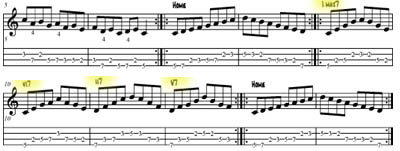
Answer:
These are chord designations, and we go into a little more detail on these page 53 of the book. You're basically spelling out chords, the six (vi7), the two (ii7), the five (V7). It's our way of "sneaking in" music theory through the physical. The intent is that after several weeks of working through these, getting them into the fingers, and ultimately the ears, an "Aha!" moment will happen. "Oh, I've been playing the "Doo wop" chords all along, and I didn't even know it!" (Think the chords to "Heart and Soul" or "Why do Fools Fall in Love?")
We didn't want to confuse people with too much theory early in the book, but it's important to at least give it a little lip service. Again, the important directive at this early stage is firmly establishing the "tactile." Through repetition, the fingerings become intuitive, so that eventually, the brain can start attacking the more cerebral aspects of harmonic/melodic construction.
Once these "labels" mean something, you'll have developed a higher brain concept that will enable you to repeat key improvisational discoveries, licks and nuggets from one tonal center to another, consciously and intuitively.
Hey. Buy the book!...
Getting Into Jazz Mandolin
Posted by Ted at 9:35 AM
 October 2, 2008 | In "Crease."
October 2, 2008 | In "Crease."
The first day of school in a junior high class can be a wild and crazy ride. New outfits, new friends, new classes, and sometimes, brand new thick textbooks. Middle School teachers can tell you the horrors of watching adolescents struggle with a brand new book (we as adults often do too!). At best, the books slam uncomfortably shut struggling to keep open; at worst, the binding can be cracked if not broken in properly.
We see this in the music publishing industry, where both hands are on an instrument, and we depend on an open face layout of two pages at a time, let alone capacity for rapid page turns in some difficult literature. From the publisher's perspective variations of three common ways of binding a book bear a set of distinct advantages and disadvantages. The wire spiral bound is the ultimate for durability and quick page turns, but they are bulky and cumbersome when stacked with other books. Sometimes, they can get caught in each other, and they are impossible to read on the shelves of a library. Comb binding (plastic) is lower profile, lighter weight, and a pretty good compromise in staying open, but the same problem exists in the inability to read the contents from a spine side view.
Ultimately, you'll see publishers favor the glued binding, but Mel Bay has adopted a great compromise in what it calls "Perfect Binding," used on its larger books. It features a square binding edge and printed spine. This is a strong binding which lies open when creased. We opted for this with our "Getting Into Jazz Mandolin" book first and foremost because we wanted to be part of the best-selling "Getting Into..." series, and also, this kind of binding is the only one accepted in most public libraries.
This may seem elementary (let alone blatantly self-indulgent), but we thought it would be good to go back to Junior High and talk about the proper way to prepare or "break in" a new book. These steps will insure a much more satisfying reading session.
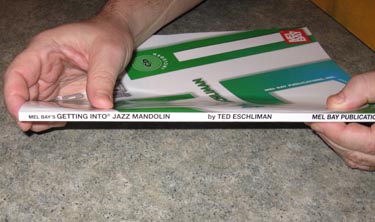
First thing you want to do is unfold the book in half, gently pressing on the inside near the spine. Make it lay as flat as you can, working the tightness out of it slowly, from center out to edge, top to bottom of the page.
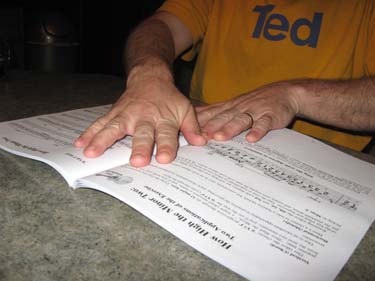
Second, you want to start "halving" the rest of the book by going to the back 1/4 of the book, repeating the break-in with the last half of the half.
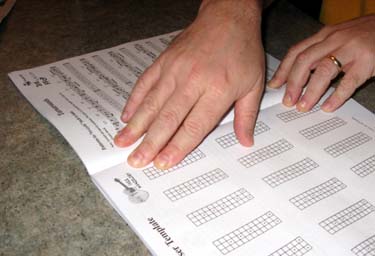
Next go to the front quarter and gently break this in the same way. After you've done this successfully, you can divide the rest of the book into 1/8ths (you're a musician--you can subdivide!) if you want to continue to unlock the binding, being careful never to stress the spine too much at a time. If you do this gradually enough, next time you use the book, it should lie flat on the music stand.
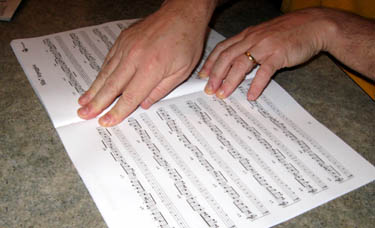
Of course, for proper posture we recommend a good music stand, something that can position the music where you can hold the instrument comfortably and turn pages effectively. We should note that we tried to write this book in a way that critical page turns would not be obstructed, but because of other compromises, we weren't able to get the 'ii V7' pages divided in a way that got around page turns. (Our apologies!)
Of course you can always take a book to a copy center for finishing services like FedEx/Kinkos, and have your book rebound with a plastic comb for a modest fee. If you're spending a lot of time in the book, this can be a worthwhile investment.
Blatant Self Promotion: Purchase Getting Into Jazz Mandolin
Now shipping!
Posted by Ted at 1:11 PM

Disclaimer: In the 'Information Age' of the 21st Century,
any fool with a computer, a modem, and an idea can
become a self-professed 'expert." This site does not
come equipped with 'discernment.'
|



